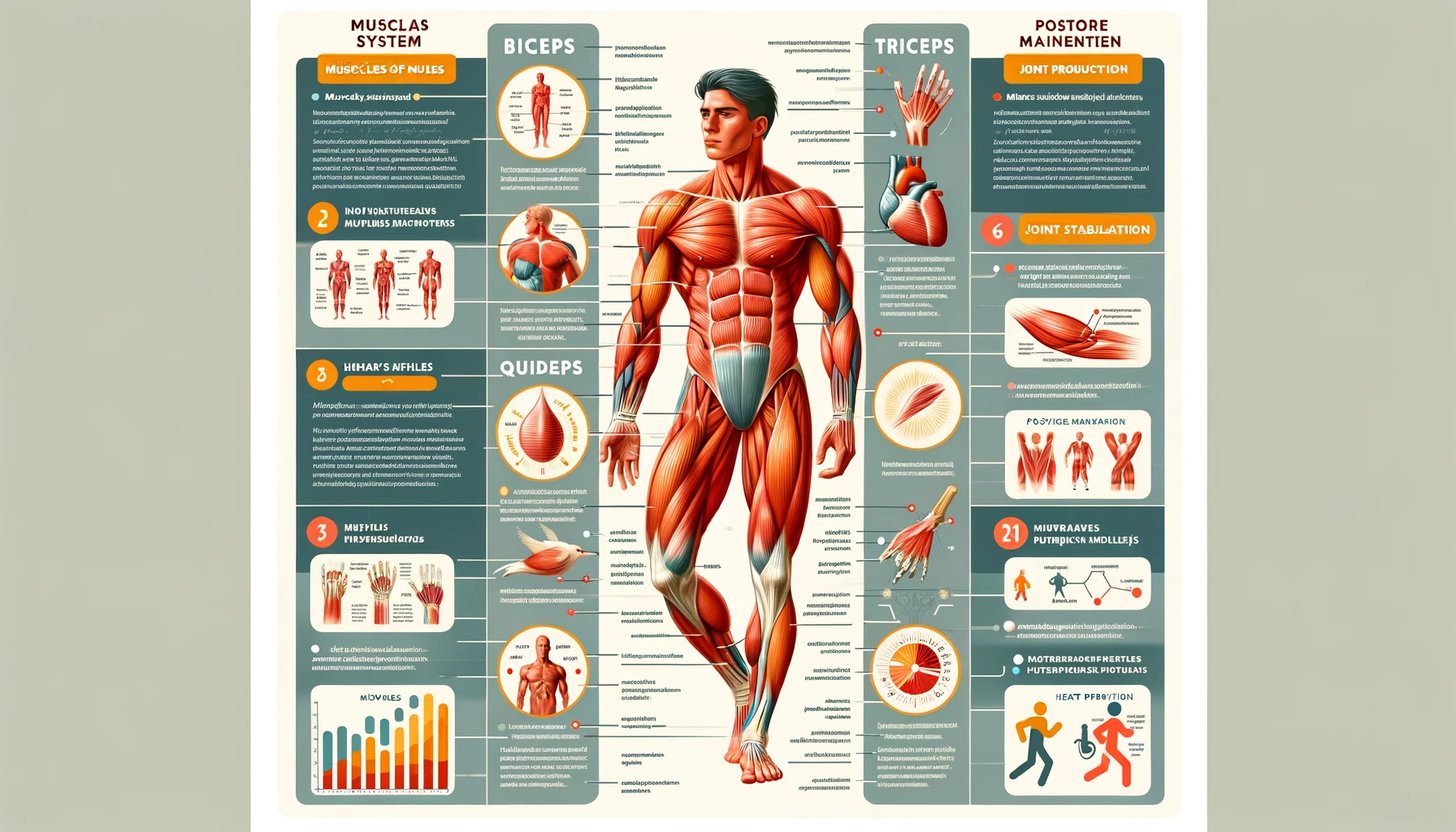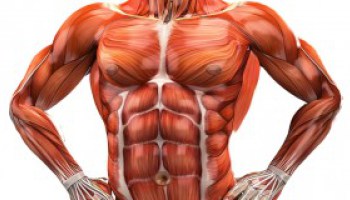Muscles system covers very important role in human body.The total number of muscles in the human body is very high: in total we have 752 muscles in our body.The overall figure is much higher than you might think, because it includes the many muscles of the face, small muscles located in the back, in the vertebrae etc. We are going to discuss the role and function of muscles in our body.

The Muscles constitute that portion of the body which we call flesh,and are the proper name of what is known as lean meat. Instead of being in one solid, continuous mass, as might be supposed, from external appearance, the flesh of the body is found to be composed of a vast number of separate pieces or strips, of various lengths and shapes, but seldom more than half an inch in thickness, each enveloped in a thin, transparent membrane, and the whole arranged in layers one above another, giving to the body bulk, form and symmetry.
These are called muscles, and by their contraction and relaxation produce the various motions of which the body is capable. The human body contains over five hundred—five, hundred and twenty seven it is said—of these muscles, the most of them being arranged in pairs.
In structure a muscle is composed of small bundles of fibers, called fasciculi, and each of these fibers is composed again of filaments or hreads. These bundles are nicely enveloped in thin cellular tissue or membrane, and the whole put together to constitute a muscle. A irreat many of the muscles terminate at one or both ends in what is
called tendon—sometimes constituting cords, as in the wrist and ankle which is a white, hard, firm, inelastic cellular substance, very strong, and is for the purpose of attaching the ends of the muscles to the bones. In some instances the tendon of a muscle spreads out or expands in its attachment, and then it is called Fascia or Aponeurosis.
This fascia or expansion of tendon becomes quite thick in some places,and serves as a protection to parts beneath, as in the palm of the hand, and sole of the foot.
Upon the arms and legs the muscles are situated around the bones,and serve to invest and defend them, while they also form to someof the joints their principal protection. Upon the trunk they are spread .out to enclose cavities, and form a defensive wall, which yieldsto internal pressure and the expansion of the body.
Muscles may be arranged into several classes, as to their shapes,and the arrangement of their fibers. Some are completely longitudinal—that is, long and spindle-shaped, each extremity terminating in a tendon; as the muscles of the arms and legs: In others the fibers are disposed like the rays of a fan, converging to a tendonous point, and constituting what is termed a radiate or broad muscle.
Again we find some with their fibers converging like the small feathers upon a quill or pen, to one side of a tendon—or it may be to both sides of it—running the whole length of the muscle. This style of muscle is called penniform.In the description of a muscle, its attachments are expressed by the terms “origin”‘ and “insertion.” The origin is the attachment to the more fixed or immovable point, or that toward which the muscle draws some other part, in its legitimate action : While the insertion is at the more movable point, or part to be acted upon.
Why Muscles System Are So Important For Human BODY
For instance the principal muscles which move the arm are attached at one end to the scapula or shoulder-blade—this is called their origin; while the other end is attached to some portion of the humerus or bones of the arm, and is called their insertion.
The principal muscles which produce the motions in the lower extremities have their origin upon some portion of the large bones of the hip or pelvis, while their insertion is upon the femur, or bones of the leg. The interstices
between the muscles, especially in young persons, are generally filled with a substance called adipose matter, or fat, which gives to the different parts of the body a round and plump appearance.
In conformity with the general divisions of the body, the muscles,like the bones, may be arranged into four parts. 1st, Those of the Head and Neck. 2d, Those of the Trunk. 3d, Those of the UpperExtremities. 4th, Those of the Lower Extremities.
In their distribution they may be said to form two layers, a superficial, and a deep-seatecl one. Though in some places there are more than this.On the back, for instance, the muscles are arranged in six layers, one
above the other, in order to produce the various and complicated movements of the back, neck, arms, chest, and abdomen. All the various movements of the body, and of its different parts, are produced by the muscles, the bones serving, in most cases, as the levers of motion.
Those muscles by which a limb is bent, are called flexors, and those by which it is straitened, extensors. These two sets of muscles are said to antagonize each other : that is, the flexors pull in one direction,and the extensors in another, so that by their alternate contraction and relaxation, two distinct and opposite motions are produced.
The muscles are also classified under the two heads of Voluntary and Involuntary. The first are such as are under the control of the will, and enable us to walk, run, leap, and perform any other voluntary act.
The muscles by which we bend the arm, open and shut the mouth, etc., are voluntary muscles, because we call them into action at pleasure, by an effort of the will.
The involuntary muscles are those over which the will has no influence. The heart is a muscular organ, acting with tremendous force in propelling the blood through the arteries; the stomach also, and the intestines have muscular coats, by which they are enabled to contract and relax for the purpose of moving their contents; yet they
are uncontroled by the will, acting independent of it, and are there-fore denominated involuntary muscles. There are others which are both voluntary and involuntary, and are therefore said to be mixed ;as the diaphragm, and other muscles of respiration.
They perform their regular functions, asleep or awake, whether we will it or not yet we can, by an effort of the will, cause them, for the time being,to act quicker, faster or slower, as we please.Muscles are acted upon and controlled by the nerves. Tractability is an inherent quality of muscular fiber, enabling it to shorten its substance, like a piece of India-rubber, when the proper stimulus is applied, and again relaxing when the stimulus is withdrawn. This stimulus is the nervous fluid, which acts upon the muscles somewhat similar to galvanism or electricity.
The muscular system plays a crucial role in the human body, encompassing a wide range of functions essential for health and daily activities. Here’s a guide in tabular format highlighting the importance of the muscular system:
| Function | Description |
|---|---|
| Movement | Muscles contract to move the body. They enable walking, running, and fine motor skills. |
| Stability & Posture | Skeletal muscles help maintain posture, stabilize joints, and support the body’s structure. |
| Protection | Muscles protect internal organs and contribute to joint stability. |
| Heat Production | Muscle activities produce heat, helping to maintain body temperature. |
| Circulation | Cardiac muscle contraction drives blood circulation throughout the body. |
| Respiration | Muscles like the diaphragm and intercostals assist in breathing. |
| Digestion | Smooth muscles in the gastrointestinal tract aid in the digestion and movement of food. |
| Metabolism | Muscles use and store energy, influencing overall metabolism. |
| Detoxification | Muscle contraction helps in lymphatic flow and detoxification. |
This table encapsulates the diverse and vital roles muscles play in the body’s overall functioning and health.
